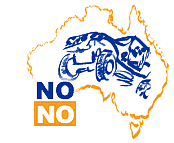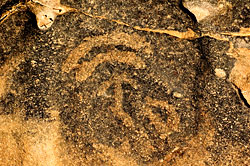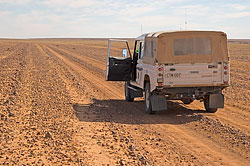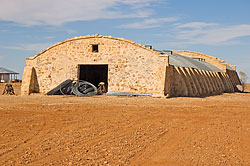 expeditionsaustralia.com
expeditionsaustralia.comAt the eastern end of the Cullyamurra Waterhole is the Innamincka Choke walking trail. About 2 km up the trail there is something very interesting – an area covered with large boulders. Some of the boulders carry carvings that were engraved by aboriginal people long ago.

The walking trail hugs the south bank of Cooper Creek frequently descending right to the edge of the water.
It’s a very enjoyable trail with various birds and plants to see along the way. If you have trouble locating aboriginal rock carvings, look for an old rusted sign on a pole near the eastern edge of the boulder field.
It is time for us to leave Innamincka, today we want to get to Birdsville some 435 km away. It’s a long drive, but we are going to make it and see some remarkable things as we do it. One such thing is just outside Innamincka, the dump site where we went to toss our accumulated rubbish. The site consists of a large rectangular hole in the ground, surrounded by fence. You just drive up, next to it, and throw your garbage over the fence into the hole – tins, bottles, cartons, egg containers, old automotive parts – everything goes in together. Simplicity endures.

As we drive through the Sturt Stony Desert the landscape becomes increasingly desolate. No more kangaroos, just plains of gibber (stone) and dust. At times the road turns into nothing more but a set of tracks in the sand. Streams we cross are mostly dry, with cows seeking refuge from the hot sun in whatever shade the sparse bushes and trees can provide.
Yep, there are cows out here, and some even on the seemingly endless gibber plain. These cows don’t give the impression of being very happy, from the looks of it, most of them consist of just skin and bones, there wouldn’t be much marbling in that meat. We drove through Cordillo Downs, once the largest property in Australia having over 80,000 sheep, since 1940’s it mostly produces cows for the grinder, including the famous Poll Herefords breed.

The main tourist attraction on the property is the defunct woolshed – the largest woolshed in Australia, it was built in 1885 from materials transported by camel. The sheep industry greatly declined in the area when Depression hit in 1930’s and the Woolshed is a great historical monument to the era long gone. There is some old machinery on display inside and around, and information of the station’s history posted on one of the interior walls.
Our next stop about 10 km south of the Queensland border is the ruins of Cadelga Homestead which was abandoned by the 1950’s.
Another 40 km north, and we turn left on the Birdsville Developmental Road. It’s 115 km that we’ll have to track back the next day, but it is well worth it because Birdsville is one of our main destinations. We arrived well after dark and our fist stop was the famous Birdsville Hotel established in 1884 where we ate a delicious dinner of pea and ham soup before rolling out our swags for the night at the Birdsville Caravan Park.
Copyright © 2005 - 2016 NoNo Expeditions Australia, Limited. All rights reserved.